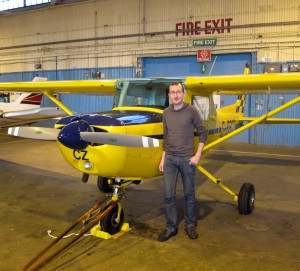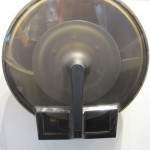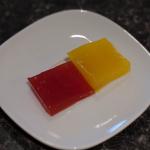Anyone that knows me has suffered my flying hobby for the last nine months; I’ve wanted to get my private pilot’s license (PPL) for a while and it was only last year that I was able to obtain my medical and afford the lessons. I thought that I’d do a writeup of my experiences along with some pointers if you’re tempted to do the same.
The first decision I had to make was a choice between the NPPL and a full JAA PPL. While the former has less stringent medical and training requirements (you merely need to get your GP to agree to the same conditions as professional lorry drivers) it does limit you to flying only during the day and in the UK. Whilst 99% of flights I’ll ever make will meet this criterion I decided to go for the full JAA PPL partly because I had vague notions of flying down to my parents in the south of France, but also I think the training course will take a similar amount of time.
This led me onto getting my Class 2 medical: I have Crohn’s disease which (if not in remission) is usually something that would disqualify me. You will need to visit an AME who will assess you (vision, hearing, ECG, bloods, urine etc) and if you’re in excellent health will issue your medical there and then. If you’re like me you’ll get your case referred to the CAA directly who will then require reports from every medic you’ve ever seen before making a decision, luckily in my favour. I would strongly advise that if you’re considering spending a lot of money on learning to fly you get your medical before doing anything else.
My next step was finding a flying school. My requirements were a little tricky in that I wanted somewhere reasonably easy to get to via public transport from central London and I’d looked at the usual suspects (Biggin Hill, Denham, Damyns Hall) but a chance reply to a post on an internet forum led me to look at RAF Halton. Although it’s way out in the Chilterns it’s pretty easy to get to and takes me 1.5 hours door-to-door on the train which is about the same time as a car. The club is excellent and while it has a rather undeserved reputation of being frosty (being a military airfield flyins are deterred) members and instructors alike are all very supportive and friendly.
So it was that I started flying in late September 2011 in a bright yellow Cessna 152 and I blogged at the time when I completed my first solo. I had always approached flying with the attitude that if I only flew solo once then I’d be satisfied even if money, health or aptitude stopped me progressing further, but of course I didn’t just stop there. I used the winter months to study for and pass all seven written exams and took full use of any ground school evenings offered by the club. I would say that my weakest exams were in Navigation and RT but the rest are certainly very easy to self study for. Bear in mind that everything may change with EASA so speak to your school about the syllabus and which books to buy.
Asides from the minimum number of hours required (45 – 10 of which must be solo including 5 hours cross country, 2 of spin & stall awareness and 2 hours instrument flying) you must complete a solo “qualifying cross country” which is a minimum of 150nm with two full stops away from home. I ended up doing mine at the end of March which took me from Halton to Gloucester, up to Leicester then back home again. At each stop you get a certificate signed by the controllers to say that you landed and a grading of your safety and landing ability.
The solo nav is certainly a testing time and requires you to be fairly proficient at using the radio as well, something that took me a fair amount of time to get used to although I think that is fairly normal. My last hurdle was the radio practical which is done on a computer simulator with you as the pilot and the examiner playing the part of all the other aircraft and controllers. I almost flunked it but to give you an idea of the contents take a look at CAA safetysense leaflet 22 which includes an example route at the end which is pretty similar to what you’ll be faced with (albeit using entirely fictitious places).
The weather in April and May has been pretty dreadful so it’s taken me a few more hours than planned to get around to the final part – the skills test – just be aware that flying in the UK will throw up a lot of cancelled flying days! But, finally the day dawned to do the test with an examiner earlier this week. The test looks at your ability to plan a route (including take off/landing performance and mass/balance), general aircraft knowledge (how much fuel, battery voltage etc), diversion planning, general handling (steep turns, stalling, slow flight) and simulated emergencies like practice forced landings.
The weather on Thursday was marginal with a 20kt wind forecast to get up to 30kts later in the day but as it was pretty much straight down the runway I decided to proceed with the test. The examiner was great and put me at my ease so we headed up and did the circuit flying part of the test first whilst the wind was comparatively light. This went ok (not my best ever landings but not surprising given the wind) then we headed off on the first leg of the navigation part. The wind wasn’t quite as forecast so I found myself off track but corrected and gave a revised ETA to the examiner and managed to arrive at the first turning point within a minute of what I’d said. Half way through the second leg I was given a diversion to plan that took us back towards home – this didn’t go so well with strengthening winds meaning that I was 2 or 3 miles off course as I neared the end point, but recovered with a newly revised ETA and just made it within the allowed 3 minutes deviation. The rest of the general handling went fine (albeit with two attempts at forced landings with the strong wind) then I was told to rejoin the circuit and land. After landing the examiner shook my hand and told me I’d passed!
I guess the last thing to say is about costs. I spent just over £6,500 on flying hours and instruction along with £700 on books, equipment, exams and membership fees. This is not a cheap hobby!
What next? I’m not sure – this was always meant to be solely for fun; I don’t want to spend vast amounts more on a commercial pilot’s license for very little return (flying instructors earn less than £20 an hour for example) so I think I’ll continue flying my little Cessna for a few more hours then convert onto a four seat machine like the PA-28 Warrior which is much more comfortable for longer trips. See you in the skies!









